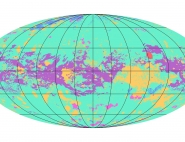Scientific Results obtained with MIMI experiment
Among the many results of this experiment, the following deserves mention:
First detection of a system of "planetary" rings around a moon:
The gas giants of our solar system are well known for the systems of rings that surround them, with Saturn's being the most spectacular. These are made up of a multitude of solid particles in equatorial orbit around the planet. These particles are composed essentially of water ice, "contaminated" with dust and some other elements. They vary in size from a few microns to several metres, and are organised in several elementary rings. The total thickness of Saturn's ring system is no more than a few tens of metres, while the diameter of the outer ring (ring E) reaches millions of km.
Saturn has at least 52 moons, of which Rhea is its largest ice moon and orbits the planet at a distance of 527,040 km, or 8.7 Saturnian radii. Rhea "bathes" in Saturn's magnetosphere, and is therefore subject to a bombardment of energetic particle plasma, which is in co-rotation with the planet. During overflights of this moon by the Cassini probe, a decrease on the energetic electron fluxes was observed in the environment of Rhea, a decrease that revealed the presence in Rhea's environment of a material that absorbed energetic electrons. The only hypothesis compatible with all the observations is the existence of an equatorial disk centred on Rhea, situated outside the trajectory of the Cassini probe, and composed of solid particles. The model developed, and adjusted to the observations, indicates that the particles that make up this ring system have a distribution of sizes around a few centimetres, going up to ~1m.
![]()
Artist's impression of the rings around Saturn's moon Rhea.
The solid particles making up these rings are not drawn to scale.
Saturn appears in the background of the image.
© NASA


